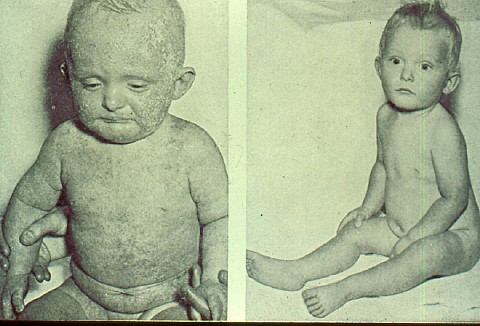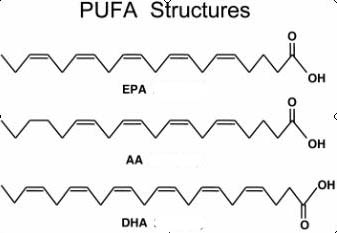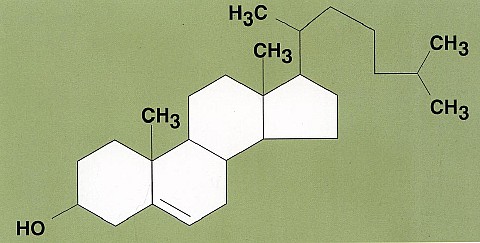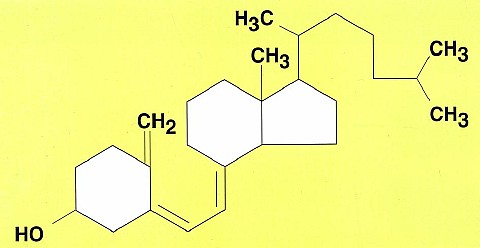Tamberly Powell, M.S., R.D.
Health Professions Division
Lane Community College
Eugene, Oregon
Additional FORUM topics for Week 5:
1. What are your thoughts about the following articles? An NPR article, "The Full-Fat Paradox: Whole Milk May Keep Us Lean", "Is Whole Milk Healthier than Fat-Free and Low-Fat?" and a newsletter written by Ellyn Satter, RD, "Should you put your child on skim milk?"
How does the information in these articles support or
conflict with the information you have learned in this class so far?
Does this information make you think differently about the type of milk
you are drinking?
Covered in Lecture 5A:
Now we're ready for:
(As mentioned before, triglycerides are the major type of lipid in food and in the body.)
B. Stomach- little or no digestion happens in the stomach, but gastric lipase digests some triglycerides.
C. Small Intestine- here is where most enzymatic digestion and absorption occurs. First fat must be emulsified, which takes place thanks to bile. Without bile, fat would simple separate out from the watery digestive juices in the small intestine.
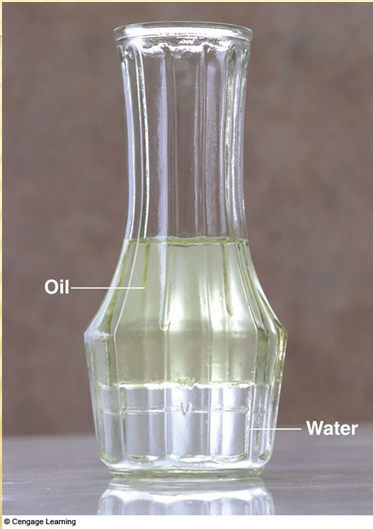
Thanks to bile, fat is able to mix with the watery digestive juices where enzymes can help break fat down into glycerol and fatty acids.
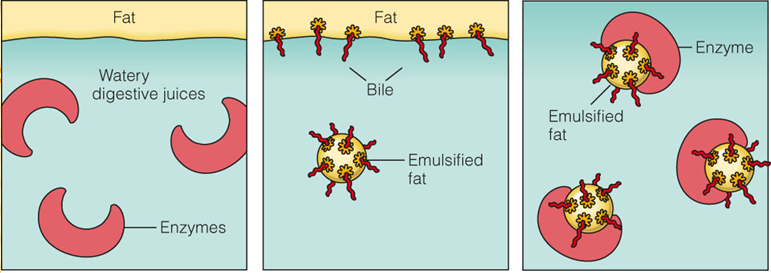
Remember bile is an emulsifier that is made in the liver and stored in the gallbladder. Bile functions in the small intestine, not the stomach. And bile is a chemical that is making a physical change. It is the enzymes that chemically break down fat.
Once triglycerides are emulsified, then triglycerides can be enzymatically digested in the small intestine. Enzymes that are made by the pancreas and small intestine are lipase enzymes. These enzymes act to split fatty acids from glycerol leaving glycerol, fatty acids, and monoglycerides to be absorbed.
Small products of lipid digestion (glycerol and shorter-chain fatty acids) can be absorbed into the intestinal cells and go directly to the blood.
Larger products of lipid digestion (monoglycerides and long chain fatty acids) need help. Once inside intestinal cells they are reformed into triglycerides, then incorporated into chylomicrons. Chylomicrons are absorbed into lymph, but eventually enter the blood and deliver triglycerides to cells.
Below is a simple animation that demonstrates how triglycerides are enzymatically digested. The animation mentions micelles (a term that is not defined or described in your text). You don't need to know about micelles for this course.
Here is the link to the above video: https://www.youtube.com/watch?v=siitsmRtMKM
Enzymatic digestion of triglycerides is complex! Try not to get too hung up on all the little details. Keep the big picture in mind. I want you to know:
-
where we find triglycerides in foods
-
that triglycerides need to be enzymatically digested
-
after enzymatic digestion glycerol, fatty acids, and monoglycerides are absorbed into intestinal cells.
Below is an example of the type of application question you will see on this material both within study questions and exams.
Q: If you drank a glass of whole milk. What carbohydrates and lipids would need to be enzymatically digested, and what would be absorbed into the cells lining the small intestine after digestion?
A: The carbohydrate in milk is lactose. Lactose is enzymatically digested down to its building blocks, glucose and galactose.
The lipid in whole milk that needs to be enzymatically digested is triglycerides. These are broken down into glycerol, fatty acids, and monoglycerides.
There is also cholesterol in whole milk (since this is an animal fat) but cholesterol is not enzymatically digested.
So, glucose, galactose, glycerol, fatty acids, monoglycerides, and cholesterol are absorbed into the cells lining the small intestine after enzymatic digestion of the carbohydrates and lipids in whole milk.
D. Absorption & Transport-
Small products of lipid digestion (glycerol and shorter-chain fatty acids) can be absorbed into the intestinal cells and go directly to the blood.
Larger products of lipid digestion (monoglycerides and long chain fatty acids) need help. Once inside intestinal cells they are reformed into triglycerides, then incorporated into chylomicrons. Chylomicrons are absorbed into lymph, but eventually enter the blood and deliver triglycerides to cells.
Below is an image of a typical lipoprotein, like a chylomicron. You can see that the triglycerides and cholesterol are tucked in the center hidden away from the watery body fluids, and protein and phospholipids are on the outside, helping to emulsify and stabilize the structure.
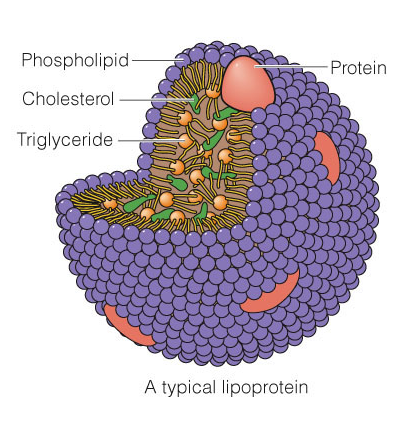
.
